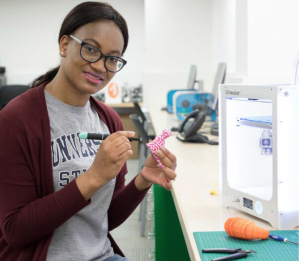Bespoke Academic Programme
As part of this module, students will hold regular meetings with the editorial team of the University’s student newspaper ‘Brig’ and will produce published pieces in their print and online platforms. Also, students will produce a website where they will publish their academic output and personal reflection (articles, videos, photos, digital models, 3D-printed objects). In our teaching venues (Lecture Theatre A1 and room 2B121), students will have access to the latest collaboration tools which enhance learning and teaching (Net Support).
Concepts in Journalism JOUU9X2
This module combines the material from several academic modules taught in the journalism programme of the Division of Communications, Media and Culture in the University of Stirling. Concepts in Journalism (JOUU9X2) is  created specifically for the Nanjing students. This module aims to engage students with key concepts in journalism studies, namely key issues raised by the debates in media ownership, journalism ethics and practice. It critically examines and evaluates theoretical positions on the study of news and the news media. This course equips students with a deep, critical and, where appropriate, philosophical understanding of journalistic professionalism and its associated problems with a focus on journalism ethics. Learning outcomes – By the end of the module you will be able to describe and assess the social and cultural influences that shape news, distinguish between and evaluate various theoretical positions on news, develop a critical understanding of processes of news and information flow. Through a range of cases and perspectives from British, Australian and US journalism and journalism academia, the course will cover some of the most salient professional issues in today’s newsrooms with a focus on (a) the characteristics of journalism as a profession, its current problems and the need for journalistic professionalisation; (b) key ethical standards in journalism; and (c) the impediments to the implementation of journalists’ social responsibilities. Throughout this course you will also explore the opportunities and threats presented by new communication technologies – especially the Internet – to journalism professionalism. This module also aims to enhance your public speaking skills. Assessment: There are two components to the assessment, each worth 50% of the grade: 1) Presentation – you will choose a case study corresponding to the aspect of journalism covered in one of the lectures and make a presentation based on it. This will take place during week 7. The presentation will be followed up by questions by students in your class. You will be graded based on the presentation and your responses and 2) An essay on one of the following questions/topics: ‘Many journalists believe that their role is to hold powerful social actors to account and to act as a watchdog against the abuse of power. Is this realistic?’ and ‘Using theories on news values compare the stories on the front page of a broadsheet and a tabloid, and discuss what values each newspaper uses to select newsworthy stories’.
created specifically for the Nanjing students. This module aims to engage students with key concepts in journalism studies, namely key issues raised by the debates in media ownership, journalism ethics and practice. It critically examines and evaluates theoretical positions on the study of news and the news media. This course equips students with a deep, critical and, where appropriate, philosophical understanding of journalistic professionalism and its associated problems with a focus on journalism ethics. Learning outcomes – By the end of the module you will be able to describe and assess the social and cultural influences that shape news, distinguish between and evaluate various theoretical positions on news, develop a critical understanding of processes of news and information flow. Through a range of cases and perspectives from British, Australian and US journalism and journalism academia, the course will cover some of the most salient professional issues in today’s newsrooms with a focus on (a) the characteristics of journalism as a profession, its current problems and the need for journalistic professionalisation; (b) key ethical standards in journalism; and (c) the impediments to the implementation of journalists’ social responsibilities. Throughout this course you will also explore the opportunities and threats presented by new communication technologies – especially the Internet – to journalism professionalism. This module also aims to enhance your public speaking skills. Assessment: There are two components to the assessment, each worth 50% of the grade: 1) Presentation – you will choose a case study corresponding to the aspect of journalism covered in one of the lectures and make a presentation based on it. This will take place during week 7. The presentation will be followed up by questions by students in your class. You will be graded based on the presentation and your responses and 2) An essay on one of the following questions/topics: ‘Many journalists believe that their role is to hold powerful social actors to account and to act as a watchdog against the abuse of power. Is this realistic?’ and ‘Using theories on news values compare the stories on the front page of a broadsheet and a tabloid, and discuss what values each newspaper uses to select newsworthy stories’.
Digital Creativity and 3D Print CMCU9DC
This module combines the study skills material from Digital Creativity and Digital Design and is created specifically for the Nanjing students. The  students will attend a two-hour lecture/workshop throughout the semester in a computer lab environment. This module introduces students to some of the themes and concepts which underpin our understanding of digital media as it operates in the world today. Students will explore the potential of the principles of creativity in digital environments. Although there will be some refresher workshops on relevant production software packages, this is not a technical skills module: the aim is to develop some of the technical aspects of digital media students have already learned, placing them within the context of critical practice, to consider their creative potential and their cultural impact. During this module, students will be supported through a number of study skills sessions which will help them to meet the challenges of honours-level study. The first component of this module provides an opportunity to broaden the understanding and applications of the basic elements and techniques that make up visual messages. You will be asked to create practice-based materials, explore creative approaches, and critically examine your own work with regards to impact and effectiveness.
students will attend a two-hour lecture/workshop throughout the semester in a computer lab environment. This module introduces students to some of the themes and concepts which underpin our understanding of digital media as it operates in the world today. Students will explore the potential of the principles of creativity in digital environments. Although there will be some refresher workshops on relevant production software packages, this is not a technical skills module: the aim is to develop some of the technical aspects of digital media students have already learned, placing them within the context of critical practice, to consider their creative potential and their cultural impact. During this module, students will be supported through a number of study skills sessions which will help them to meet the challenges of honours-level study. The first component of this module provides an opportunity to broaden the understanding and applications of the basic elements and techniques that make up visual messages. You will be asked to create practice-based materials, explore creative approaches, and critically examine your own work with regards to impact and effectiveness.
At a time when so much information is being studied through non-verbal channels, these sessions aim to provide you with a beginners level of visual awareness in order for to extract more meaning from the world around us. The second component will allow students to learn about digital design, learn and practice digital design skills with design programmes and apply their skills in the ‘Maker Space’ located in the Library which has two 3D printers, a 3D scanner and a laser cutter. Separate induction and practice sessions with the Information Centre staff will aim to prepare you for using this space.
Learning outcomes – By the end of the course students will be equipped with knowledge and confidence to engage with visual messages and will have increased their digiral literacy. These skills will be applied to complete the assessments in the rest of the academic modules as well as learn how to design and print 3D objects. Assessment: The assessment for this module is worth 100% of the grade. The students will be asked to design and print a 3D object each. They will be marked on the quality of their design and print object. Application: This module will help you with your portfolio and webstie where you will publish your assignments and work produced during your stay at the University of Stirling.

